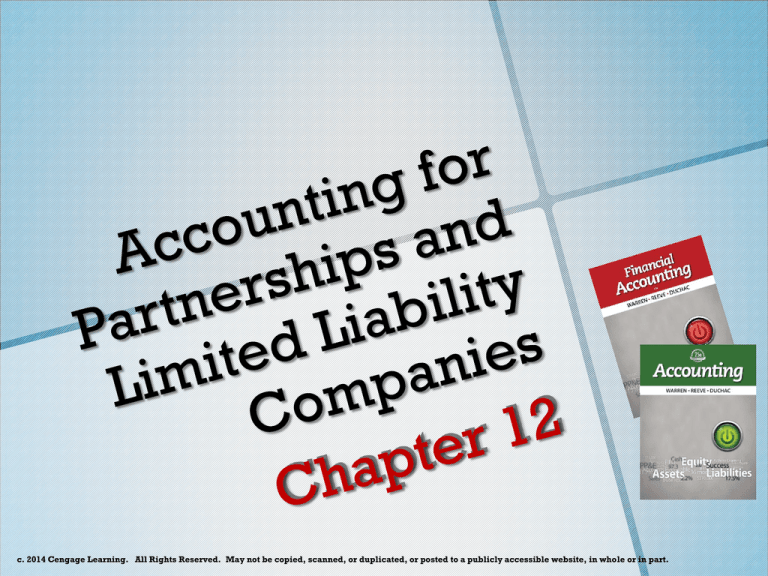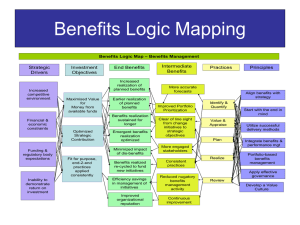
c. 2014 Cengage Learning. All Rights Reserved. May not be copied, scanned, or duplicated, or posted to a publicly accessible website, in whole or in part.
Learning Objectives
1. Describe the characteristics of proprietorships,
partnerships, and limited liability companies.
2. Describe and illustrate the accounting for
forming a partnership and for dividing the net
income and net loss of a partnership.
3. Describe and illustrate the accounting for partner
admission and withdrawal.
4. Describe and illustrate the accounting for
liquidating a partnership.
5. Prepare the statement of partnership equity.
6. Analyze and interpret employee efficiency.
c. 2014 Cengage Learning. All Rights Reserved. May not be copied, scanned, or duplicated, or posted to a publicly accessible website, in whole or in part.
Four Most Common Legal Forms of Business
o Proprietorship
o Corporation
o Partnership
o Limited Liability Company
Proprietorship
o A proprietorship is a company owned by a
single individual.
Lawyers
Architects
Realtors
Physicians
Proprietorships
o Characteristics of proprietorships include the
following:
Simple to form
No limitation on legal liability
Not taxable
Limited life
Limited ability to raise capital (funds)
Partnerships
o A partnership is an association of two or more
persons who own and manage a business for
profit. Characteristics of a partnership include
the following:
Moderately complex to form
• A partnership requires a partnership agreement,
sometimes called the articles of partnership, which
includes matters such as amounts to be invested, limits on
withdrawals, distributions of income and losses, and
admission and withdrawal of partners.
Partnerships
No limitation on legal liability
Not taxable
Limited life
Limited ability to raise capital (funds)
Partnerships
o In addition to the characteristics listed on the
previous slides, some unique aspects of
partnerships are:
Co-ownership of partnership property
Mutual agency
Participation in income
Limited Liability Companies
o A limited liability company (LLC) is a form of
legal entity that provides limited liability to its
owners, but is treated as a partnership for tax
purposes. Characteristics include:
Moderately complex to form
Limited legal liability
Not taxable
Unlimited life
Moderate ability to raise capital (funds)
COMPARING
PROPRIETORSHIPS,
PARTNERSHIPS, AND
LIMITED LIABILITY
COMPANIES
COMPARING
PROPRIETORSHIPS,
PARTNERSHIPS, AND
LIMITED LIABILITY
COMPANIES
COMPARING
PROPRIETORSHIPS,
PARTNERSHIPS, AND
LIMITED LIABILITY
COMPANIES
c. 2014 Cengage Learning. All Rights Reserved. May not be copied, scanned, or duplicated, or posted to a publicly accessible website, in whole or in part.
Forming a Partnership
o Joseph Stevens and Earl Foster, owners of
competing hardware stores, agree to combine
their businesses in a partnership. Stevens
agrees to contribute the following:
Forming a Partnership
o The entry to record the assets and liabilities
contributed by Stevens is as follows:
o The noncash assets are normally recorded at
current market value.
Forming a Partnership
o If a limited liability company is formed, the
following entry is made:
Dividing Income—Services of Partners
o The partnership agreement of Jennifer Stone
and Crystal Mills provides for Stone to receive
a monthly salary allowance of $5,000 ($60,000
annually) and Mills to receive $4,000 a month
($48,000 annually). If there is any remaining
net income, it is to be divided equally.
Income and losses of the partnership would have
been divided equally if no partnership agreement
existed or if the partnership agreement did not
specify how the division was to occur.
Dividing Income—Services of Partners
o The firm had net income of $150,000 for the
year. Stone shared the net income as
calculated below.
Annual salary allowance
J. Stone
C. Mills
$60,000
$48,000 $108,000
12 x Stone’s 12 x Mill’s
monthly salary
monthly salary
allowance allowance
Total
Dividing Income—Services of Partners
o The firm had net income of $150,000 for the
year. Stone shared the net income as
calculated below.
J. Stone
C. Mills
Total
Annual salary allowance
Remaining income
$60,000
21,000
$48,000 $108,000
21,000
42,000
Division of net income
$81,000
$69,000 $150,000
Dividing Income—Services of Partners
o The firm had net income of $150,000 for the
year. Stone shared the net income as
calculated below.
J. Stone
C. Mills
Total
Annual salary allowance
Remaining income
$60,000
21,000
$48,000 $108,000
21,000
42,000
Division of net income
$81,000
$69,000 $150,000
Dividing Income—Services of Partners and
Investments
o The partnership agreement for Stone and Mills
divides income as follows:
Partner salary allowances: $5,000 monthly for Stone
and $4,000 monthly for Mills
Interest of 12% on each partner’s capital balance as
of January 1
Any remaining income divided equally
Dividing Income—Services of Partners and
Investments
o Each partner’s annual salary allowance is
calculated.
J. Stone
Salary allowance
$60,000
C. Mills
Total
$48,000 $108,000
$5,000 x 12 $4,000 x 12
Dividing Income—Services of Partners and
Investments
o Interest on each partner’s January 1 capital
balance is determined.
J. Stone
Salary allowance
Interest allowance
$60,000
19,200
C. Mills
Total
$48,000 $108,000
14,400
33,600
12% x Stone’s
12% x Mill’s
capital account
capital account
balance of $160,000
balance of
on Jan.$120,000
1.
on Jan. 1.
Dividing Income—Services of Partners and
Investments
o At this point, $141,600 of the $150,000 has been
assigned. The remaining $8,400 is divided
equally.
J. Stone
Salary allowance
Interest allowance
Remaining income
Net income
$60,000
19,200
4,200
$83,400
C. Mills
Total
$48,000 $108,000
14,400
33,600
4,200
8,400
$66,600 $150,000
Dividing Income—Services of Partners and
Investments
o At this point, $141,600 of the $150,000 has been
assigned. The remaining $8,400 is divided
equally.
J. Stone
Salary allowance
Interest allowance
Remaining income
Net income
$60,000
19,200
4,200
$83,400
C. Mills
Total
$48,000 $108,000
14,400
33,600
4,200
8,400
$66,600 $150,000
Dividing Income—Allowances Exceed Net
Income
o Assume the same salary and interest
allowances as in the preceding example, but
that the net income is only $100,000. In this
case, the total of the allowances exceeds the
net income by $41,600 ($100,000 - $141,600).
Dividing Income—Allowances Exceed Net
Income
o The division of net income is determined as
follows:
J. Stone
Salary allowance
Interest allowance
Total
$60,000
19,200
$79,200
C. Mills
Total
$48,000 $108,000
14,400
33,600
$62,400 $141,600
This amount exceeds
net income by
$41,600.
Dividing Income—Allowances Exceed Net
Income
o The division of net income is determined as
follows:
J. Stone
Salary allowance
$60,000
Interest allowance
19,200
Total
$79,200
Deduct excess of
allowances over income 20,800
Net income
$58,400
C. Mills
Total
$48,000 $108,000
14,400
33,600
$62,400 $141,600
20,800
41,600
$41,600 $100,000
Dividing Income—Allowances Exceed Net
Income
c. 2014 Cengage Learning. All Rights Reserved. May not be copied, scanned, or duplicated, or posted to a publicly accessible website, in whole or in part.
Admitting a Partner
o A person may be admitted to a partnership by
either of the following:
Purchasing an interest from one or more of the
existing partners
Contributing assets to the partnership
ADMITTING A
PARTNER
Purchasing an Interest from Existing Partners
o On June 1, Tom Andrews and Nathan Bell each
sell one-fifth of their partnership equity of
Bring It Consulting to Joe Canter for $10,000 in
cash. On June 1, the partnership has net assets
of $100,000, and both existing partners have
capital balances of $50,000 each.
Purchasing an Interest from Existing Partners
o The only entry required in the partnership
accounts is as follows:
o For a limited liability company, the following
entry is required:
Purchasing an Interest from Existing Partners
o The effect of the transaction on the partnership
accounts is shown in the following diagram.
Contributing Assets to a Partnership
o Partners Tom Andrews and Nathan Bell each
have capital balances of $50,000. On June 1, Joe
Canter contributes $20,000 cash to Bring It
Consulting for ownership equity of $20,000.
Contributing Assets to a Partnership
o The entry to record this transaction is as
follows:
o For a limited liability company, the following
entry is required:
Contributing Assets to a Partnership
o The effect of the transaction on the partnership
accounts is shown in the following diagram.
Revaluation of Assets
o If the partnership’s asset accounts do not
reflect approximate current market values
when a new partner is admitted, the accounts
should be adjusted (increased or decreased)
before the new partner is admitted.
Revaluation of Assets
o Partners Andrews and Bell each have capital
balances of $50,000. The balance in
Merchandise Inventory is $14,000, and the
current replacement value is $17,000. The
partners share net income equally.
Revaluation of Assets
o The entry to record this transaction is as
follows:
o For a limited liability company, the following
entry is required:
PARTNER BONUSES
Partner Bonuses
o On March 1, the partnership of Marsha Jenkins
and Helen Kramer admits Alex Diaz as a new
partner. The assets of the old partnership are
adjusted to current market values, and the
resulting capital balances for Jenkins and
Kramer are $20,000 and $24,000, respectively.
Jenkins and Kramer share profits and losses
equally.
Partner Bonuses
o Jenkins and Kramer agree to admit Diaz to the
partnership for $31,000. In return, Diaz will
receive a one-third equity in the partnership
and will share income and losses equally with
Jenkins and Kramer. Diaz is paying Jenkins and
Kramer a $6,000 bonus to join the partnership.
The computation is on the next slide.
Partner Bonuses
Partner Bonuses
o The entry to record this transaction is as
follows:
o For a limited liability company, the following
entry is required:
Partner Bonuses
o After adjusting assets to market values, the
capital balance of partner Janice Cowen is
$80,000, and the capital balance of partner
Steve Dodd is $40,000. Ellen Chou will receive
a one-fourth interest in the partnership for a
contribution of $30,000. Before admitting Chou,
Cowen and Dodd shared net income using a
2:1 ratio. In this case, Cowen and Dodd are
paying Chou a $7,500 bonus to join the
partnership. The computation is on the next
slide.
Partner Bonuses
Partner Bonuses
o The entry to record this transaction is as
follows:
o For a limited liability company, the following
entry is required:
Withdrawal of a Partner
o A partner may retire or withdraw from a
partnership. In such cases, the withdrawing
partner’s interest is normally sold to the:
Existing partners or
Partnership
Withdrawal of a Partner
o If the existing partners purchase the
withdrawing partner’s interest, the purchase
and sale of the partnership interest is between
the partners as individuals. The only entry is:
To debit the capital account of the partner
withdrawing, and
To credit the capital account of the partner or
partners buying the additional interest.
Withdrawal of a Partner
o If the partnership purchases the withdrawing
partner’s interest, the assets and the owners’
equity of the partnership are reduced by the
purchase price.
Death of a Partner
o When a partner dies, the partnership accounts
should be closed as of the date of death. The
net income for the current period should then
be determined and divided among the
partners’ capital accounts.
c. 2014 Cengage Learning. All Rights Reserved. May not be copied, scanned, or duplicated, or posted to a publicly accessible website, in whole or in part.
Liquidating Partnerships
o When a partnership goes out of business, the
winding-up process is called the liquidation of
the partnership.
Although liquidation refers to the payment of
liabilities, it includes the entire winding-up process.
When the partnership goes out of business and the
normal operations are discontinued, the accounts
should be adjusted and closed.
Liquidating Partnerships
The selling of
partnership assets
is called
realization.
Liquidating Partnerships
o In liquidation, cash is distributed to each
partner based on his or her final capital
balance.
Liquidating Partnerships
o Farley, Green, and Hall decide to liquidate
their partnership. On April 9, after
discontinuing business operations and closing
the accounts, the following trial balance is
prepared:
Gain on Realization
o Farley, Green, and Hall share income and losses in
a ratio of 5:3:2 (50%, 30%, 20%).
o All noncash assets are sold in a single transaction
for $72,000, resulting in a gain of $8,000. Partner
capital accounts are credited $4,000, $2,400, and
$1,600 to Farley, Green, and Hall, respectively.
o Creditors are paid $9,000, and the remaining cash
of $74,000 is distributed to the partners.
o A statement of partnership liquidation, which
summarizes the liquidation process, is shown in
Exhibit 5 on the next slide.
GAIN ON
REALIZATION
Gain on Realization
Sale of Assets (Step 1)
Gain on Realization
Division of Gain (Step 2)
Gain on Realization
Payment of Liabilities (Step 3)
Gain on Realization
Distribution of Cash to Partners (Step 4)
Loss on Realization
o Farley, Green, and Hall sell all noncash assets
for $44,000. A loss of $20,000 ($64,000 –
$44,000) is realized. The loss is distributed to
Farley, Green, and Hall in the income-sharing
ratio of 5:3:2.
Loss on Realization
Loss on Realization
Sale of Assets (Step 1)
Liquidating Partnerships
Division of Loss (Step 2)
Liquidating Partnerships
Payment of Liabilities (Step 3)
Liquidating Partnerships
Distribution of Cash to Partners (Step 4)
EXAMPLE EXERCISE
Loss on Realization—Capital Deficiency
o The share of a loss on realization may be
greater than the balance in a partner’s capital
account. The resulting debit balance in the
capital account is called a deficiency.
Loss on Realization—Capital Deficiency
o Farley, Green, and Hall sell all of the noncash
assets for $10,000. A loss of $54,000 ($64,000 –
$10,000) is realized. The share of the loss
allocated to Farley, $27,000 (50% of $54,000),
exceeds the $22,000 balance in her capital
account. Farley contributes $5,000 to the
partnership.
LOSS ON
REALIZATION—
CAPITAL DEFICIENCY
Loss on Realization—Capital Deficiency
Sale of Assets (Step 1)
Loss on Realization—Capital Deficiency
Division of Loss (Step 2)
Loss on Realization—Capital Deficiency
Payment of Liabilities (Step 3)
Loss on Realization—Capital Deficiency
Receipt of Deficiency (Step 4)
Loss on Realization—Capital Deficiency
Distribution of Cash to Partners (Step 4)
Partner Does Not Pay Deficiency
o If Farley does not pay her deficiency, the
deficiency would be allocated to Green and
Hall based on their income-sharing ratio of 3:2.
The remaining cash would be distributed to
Green and Hall as shown below:
Partner Does Not Pay Deficiency
o Allocation of deficiency:
Partner Does Not Pay Deficiency
o Distribution of cash to partners:
c. 2014 Cengage Learning. All Rights Reserved. May not be copied, scanned, or duplicated, or posted to a publicly accessible website, in whole or in part.
Statement of Partnership Equity
o The changes in the partners’ capital accounts
for a period of time are reported in a statement
of partnership equity.
o The statement of members’ equity for an LLC is
similar to that of a partnership. It reports the
changes in member equity for a period.
STATEMENT OF
PARTNERSHIP
EQUITY
c. 2014 Cengage Learning. All Rights Reserved. May not be copied, scanned, or duplicated, or posted to a publicly accessible website, in whole or in part.
Revenue per Employee
o Revenue per employee is a measure of the
efficiency of the business in generating
revenues.
Revenue per Employee =
Revenue
Number of Employees
Revenue per Employee
2015
Revenues
Number of employees
Revenue per
employee, 2015
Revenue per
employee, 2014
2014
$220,000,000
1,600
$180,000,000
1,500
=
$220,000,000
1,600
= $137,500
=
$180,000,000
1,500
= $120,000
c. 2014 Cengage Learning. All Rights Reserved. May not be copied, scanned, or duplicated, or posted to a publicly accessible website, in whole or in part.









